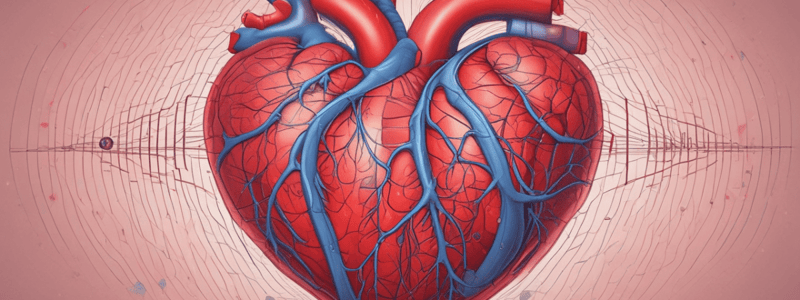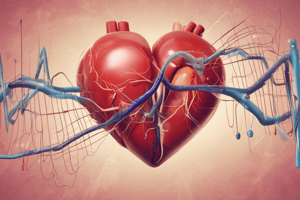Podcast
Questions and Answers
What is the primary mechanism by which the renin-angiotensin-aldosterone system increases peripheral resistance?
What is the primary mechanism by which the renin-angiotensin-aldosterone system increases peripheral resistance?
- Increasing the formation of angiotensin II (correct)
- Enhancing the release of aldosterone
- Directly stimulating the release of natriuretic peptides
- Inhibiting the activity of β-adrenergic receptors
Which of the following is NOT a compensatory response to heart failure?
Which of the following is NOT a compensatory response to heart failure?
- Activation of the renin-angiotensin-aldosterone system
- Increased parasympathetic activity (correct)
- Increased sympathetic activity
- Release of natriuretic peptides
What is the primary effect of increased sympathetic activity on the heart in heart failure?
What is the primary effect of increased sympathetic activity on the heart in heart failure?
- Increased heart rate and contractility (correct)
- Decreased heart rate and contractility
- Decreased venous return and cardiac preload
- Increased peripheral resistance and cardiac output
Which of the following is a beneficial effect of natriuretic peptides in heart failure?
Which of the following is a beneficial effect of natriuretic peptides in heart failure?
What is the primary mechanism by which increased preload increases cardiac output?
What is the primary mechanism by which increased preload increases cardiac output?
What is the ultimate effect of the renin-angiotensin-aldosterone system on cardiac function?
What is the ultimate effect of the renin-angiotensin-aldosterone system on cardiac function?
What is the role of neprilysin enzyme in the body?
What is the role of neprilysin enzyme in the body?
What is the primary stimulus for the release of renin in heart failure?
What is the primary stimulus for the release of renin in heart failure?
Which of the following is a long-term consequence of the compensatory responses to heart failure?
Which of the following is a long-term consequence of the compensatory responses to heart failure?
What is the effect of inhibiting neprilysin on bradykinin levels?
What is the effect of inhibiting neprilysin on bradykinin levels?
What is the effect of natriuretic peptides on sodium levels in the blood?
What is the effect of natriuretic peptides on sodium levels in the blood?
What is the therapeutic use of an ARNI in patients with HFrEF?
What is the therapeutic use of an ARNI in patients with HFrEF?
What is the effect of sacubitril/valsartan on afterload, preload, and myocardial fibrosis?
What is the effect of sacubitril/valsartan on afterload, preload, and myocardial fibrosis?
What is the benefit of using an ARNI over an ACE inhibitor in patients with HFrEF?
What is the benefit of using an ARNI over an ACE inhibitor in patients with HFrEF?
What is the reason for combining an ARB with a neprilysin inhibitor?
What is the reason for combining an ARB with a neprilysin inhibitor?
What happens to sacubitril in the body?
What happens to sacubitril in the body?
What is the primary mechanism of digoxin elimination in the body?
What is the primary mechanism of digoxin elimination in the body?
What is the initial indicator of digoxin toxicity in patients?
What is the initial indicator of digoxin toxicity in patients?
What is the effect of decreased serum potassium levels on digoxin toxicity?
What is the effect of decreased serum potassium levels on digoxin toxicity?
What is the primary mechanism of action of ivabradine?
What is the primary mechanism of action of ivabradine?
What is the mechanism of action of β-adrenergic agonists in increasing cardiac contractility?
What is the mechanism of action of β-adrenergic agonists in increasing cardiac contractility?
What is the benefit of ivabradine in patients with HFrEF?
What is the benefit of ivabradine in patients with HFrEF?
What is the effect of phosphodiesterase inhibitors on cardiac contractility?
What is the effect of phosphodiesterase inhibitors on cardiac contractility?
What is the contraindication for the use of ARNI in patients with a history of?
What is the contraindication for the use of ARNI in patients with a history of?
What is the primary function of neprilysin in the body?
What is the primary function of neprilysin in the body?
What is the main adverse effect of ARNI similar to that of an ACE inhibitor or ARB?
What is the main adverse effect of ARNI similar to that of an ACE inhibitor or ARB?
What is the possible consequence of severe digoxin toxicity?
What is the possible consequence of severe digoxin toxicity?
What is the recommended dosing frequency for sacubitril/valsartan?
What is the recommended dosing frequency for sacubitril/valsartan?
What is the common complication of thiazide or loop diuretics in patients receiving digoxin?
What is the common complication of thiazide or loop diuretics in patients receiving digoxin?
What is the pharmacokinetic characteristic of ivabradine?
What is the pharmacokinetic characteristic of ivabradine?
What is the benefit of using ivabradine in patients with HFrEF?
What is the benefit of using ivabradine in patients with HFrEF?
What is the effect of ARNI on bradykinin levels?
What is the effect of ARNI on bradykinin levels?
What is the primary route of excretion for sacubitril?
What is the primary route of excretion for sacubitril?
What is the effect of inhibiting the HCN channel on the heart rate?
What is the effect of inhibiting the HCN channel on the heart rate?
What is the benefit of using ivabradine in patients with HFrEF?
What is the benefit of using ivabradine in patients with HFrEF?
What is the effect of sacubitril on bradykinin levels?
What is the effect of sacubitril on bradykinin levels?
What is the primary mechanism of action of ivabradine?
What is the primary mechanism of action of ivabradine?
What is the recommended administration of ivabradine?
What is the recommended administration of ivabradine?
What is the effect of sacubitril on afterload?
What is the effect of sacubitril on afterload?
What is the contraindication for the combination of sacubitril and valsartan?
What is the contraindication for the combination of sacubitril and valsartan?
Flashcards are hidden until you start studying
Study Notes
Heart Failure
- Heart failure evokes three major compensatory mechanisms to enhance cardiac output:
- Increased sympathetic activity
- Activation of the renin-angiotensin-aldosterone system
- Activation of natriuretic peptides
Compensatory Mechanisms
- Increased sympathetic activity:
- Baroreceptors sense a decrease in blood pressure and activate the sympathetic nervous system
- Stimulation of β-adrenergic receptors results in an increased heart rate and a greater force of contraction
- Vasoconstriction enhances venous return and increases cardiac preload
- An increase in preload increases stroke volume, which in turn increases cardiac output
Activation of the Renin-Angiotensin-Aldosterone System
- A fall in cardiac output (COP) decreases blood flow to the kidney, prompting the release of renin
- Release of renin results in increased formation of angiotensin II and aldosterone
- Increased peripheral resistance (afterload) and retention of sodium and water
- Increased volume returns to the heart, increasing cardiac preload
Activation of Natriuretic Peptides
- Increase in preload also increases the release of natriuretic peptides
- Natriuretic peptides (atrial, B-type, and C-type) have differing roles in heart failure
- Atrial and B-type natriuretic peptides are the most important
- Activation of natriuretic peptides results in:
- Vasodilation
- Natriuresis
- Inhibition of renin and aldosterone release
- Reduction in myocardial fibrosis
Pharmacological Treatment
- Digoxin:
- Increases the force of contraction (inotropic effect)
- Long half-life of 30-40 hours
- Eliminated by the kidney, requiring dose adjustment in renal dysfunction
- Common adverse reactions: anorexia, nausea, vomiting, blurred vision, and cardiac arrhythmias
- Toxicity can be managed by discontinuing digoxin, determining serum potassium levels, and replenishing potassium if necessary
β-Adrenergic Agonists
- β-Adrenergic agonists (dobutamine and dopamine):
- Cause positive inotropic effects and vasodilation
- Increase intracellular cAMP, leading to the activation of protein kinase
- Protein kinase phosphorylates slow calcium channels, increasing entry of calcium ions into the myocardial cells and enhancing contraction
Phosphodiesterase Inhibitors
- Milrinone:
- Increases the intracellular concentration of cAMP
- Results in an increase in intracellular calcium and cardiac contractility
Angiotensin Receptor-Neprilysin Inhibitor
- Sacubitril/valsartan:
- Combines the actions of an angiotensin receptor blocker (ARB) with neprilysin inhibition
- Inhibition of neprilysin results in increased concentration of vasoactive peptides, leading to:
- Natriuresis
- Diuresis
- Vasodilation
- Inhibition of fibrosis
- Decreases afterload, preload, and myocardial fibrosis
- Improves survival and symptoms of heart failure compared to therapy with an ACE inhibitor
Hyperpolarization-Activated Cyclic Nucleotide-Gated Channel Blocker
- Ivabradine:
- Selectively slows the If current in the SA node, reducing heart rate
- Does not reduce contractility, AV conduction, ventricular repolarization, or blood pressure
- Used in heart failure with reduced ejection fraction (HFrEF) to improve symptoms in patients who are in sinus rhythm with a heart rate above 70 beats per minute and are on optimized HF pharmacotherapy
Studying That Suits You
Use AI to generate personalized quizzes and flashcards to suit your learning preferences.




